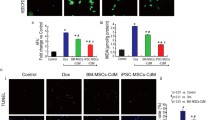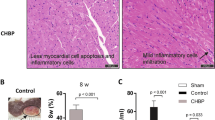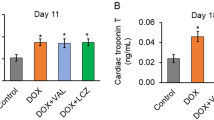Abstract
Introduction
Doxorubicin (DOX) is a highly effective chemotherapeutic agent related to dose-dependent cardiomyopathy. Recent evidence suggests that erythropoietin (EPO) can play a protective role in cardiovascular diseases by non-erythropoietic effects. In the present study, we tested the hypothesis that EPO may protect against DOX-induced cardiomyopathy through anti-apoptotic mechanisms both in vitro and in vivo.
Materials and methods
Isolated neonatal Wistar rat cardiomyocytes were treated with vehicle, DOX with or without EPO, or EPO. Twenty-four hours later, the cells were used to determine cardiomyocyte apoptosis (TUNEL assay). Cardiomyopathy was induced in Wistar rats by intraperitoneal injections (IP) of DOX (2.5 mg/kg, six times for 2 weeks). EPO (2,500 U/kg, six times for 2 weeks) was administered simultaneously in the DOX+EPO group and the EPO group. Two weeks after the last administration, cardiac function was evaluated by echocardiography and invasive haemodynamic measurements. Rats were then sacrificed for histological and TUNEL analyses, with immunological detection for cardiac Troponin-T (cTnT), α-actinin, Bax and Bcl-2.
Results
EPO significantly ameliorated DOX-induced apoptosis of cultured cardiomyocytes as demonstrated by TUNEL assay. In the rat model, cardiac function significantly decreased in the DOX group. In contrast, the DOX+EPO group showed considerable improvement in cardiac function, inhibition of cardiomyocyte apoptosis, reduction of fibrosis, as well as up-regulation of Bcl-2 protein expression.
Conclusions
Our results suggest that EPO exerts preventive cardioprotective effects on DOX-induced cardiomyopathy via anti-apoptotic pathways. The up-regulation of Bcl-2 protein expression may contribute to this.





Similar content being viewed by others
References
Li K, Sung RYZ, Huang WZ, et al. Thrombopoietin protects against in vitro and in vivo cardiotoxicity induced by doxorubicin. Circulation 2006;113:2211–20.
Khan M, Varadharaj S, Shobha JC, et al. C-Phycocyanin Ameliorates Doxorubicin-Induced Oxidative Stress and Apoptosis in Adult Rat Cardiomyocytes. J Cardiovasc Pharmacol 2006;47:9–20.
Kotamraju S, Konorev EA, Joseph J, et al. Doxorubicin-induced apoptosis in endothelial cells and cardiomyocytes is ameliorated by nitrone spin traps and ebselen. Role of reactive oxygen and nitrogen species. J Biol Chem 2000;275:33585–92.
Kluza J, Marchetti P, Gallego M-A, et al. Mitochondrial proliferation during apoptosis induced by anticancer agents: effects of doxorubicin and mitoxantrone on cancer and cardiac cells. Oncogene 2004;23:7018–30.
Childs AC, Phaneuf SL, Dirks AJ, Phillips T, Leeuwenburgh C. Doxorubicin treatment in vitro causes cytochrome c release and cardiomyocyte apoptosis, as well as increased mitochondrial efficiency, superoxide dismutase activity, and Bcl-2: Bax ratio. Cancer Res 2002;62:4592–8.
Kluza J, Marchetti P, Gallego MA, et al. Mitochondrial proliferation during apoptosis induced by anticancer agents: effects of doxorubicin and mitoxantrone on cancer and cardiac cells. Oncogene 2004;23:7018–30.
Wang S, Konorev EA, Kotamraju S, et al. Doxorubicin induces apoptosis in normal and tumor cells via distinctly different mechanisms. J Biol Chem 2004;279:25535–43.
Simpson C, Herr H, Courville KA. Concurrent therapies that protect against doxorubicin-induced cardiomyopathy. Clin J Oncol Nurs 2004;8:497–501.
Iarussi D, Indol P, Casale F, et al. Recent advances in the prevention of anthracycline cardiotoxicity in childhood. Curr Med Chem 2001;8:1649–60.
van der Meer P, Voors AA, Lipsic E, et al. Erythropoietin in cardiovascular diseases. Eur Heart J 2004;25:285–91.
Li L, Takemura G, Li Y, et al. Preventive effect of erythropoietin of cardiac dysfunction in doxorubicin-induced cardiomyopathy. Circulation 2006;113:535–43.
Hamed S, Barshack I, Luboshits G, et al. Erythropoietin improves myocardial performance in doxorubicin-induced cardiomyopathy. Eur Heart J 2006;27:1876–83.
Parsa CJ, Matsumoto A, Kim J, et al. A novel protective effect of erythropoietin in the infarcted heart. J Clin Invest 2003:112:999–1007.
Hirata A, Minamino T, Asanuma H, et al. Erythropoietin Just Before Reperfusion Reduces Both Lethal Arrhythmias and Infarct Size via the Phosphatidylinositol-3 Kinase-Dependent Pathway in Canine Hearts. Cardiovasc Drug Ther 2005;19:33–40.
Chlopcikova S, Psotova J, Miketova P. Neonatal rat cardiomyocytes: a model for the study of morphological, biochemical and electrophysiological characteristics of the heart. Biomed Pap Med Fac Univ Palacky Olomouc Czech Repub 2001;145:49–55.
Fisher PW, Salloum F, Das A, et al. Phosphodiesterase-5 inhibition with sildenafil attenuates cardiomyocyte apoptosis and left ventricular dysfunction in a chronic model of doxorubicin cardiotoxicity. Circulation 2005;111:1601–10.
Chatterjee S, Stewart AS, Bish LT, et al. Viral gene transfer of the antiapoptotic factor Bcl-2 protects against chronic postischemic heart failure. Circulation 2002;106:I-212–7.
Hou XW, Son J, Wang Y, et al. Granulocyte colony-stimulating factor reduces cardiomyocyte apoptosis and improves cardiac function in adriamycin-induced cardiomyopathy in rats. Cardiovasc Drug Ther 2006;20:85–91.
Calvillo L, Latini R, Kajstura J, et al. Recombinant human erythropoietin protects the myocardium from ischemia–reperfusion injury and promotes beneficial remodeling. Proc Natl Acad Sci USA 2003;100:4802–6.
Bogoyevitch MA. An update on the cardiac effects of erythropoietin cardioprotection by erythropoietin and the lessons learnt from studies in neuroprotection. Cardiovasc Res 2004;63:208–16.
Nomoto T, Nishina T, Miwa S, et al. Angiotensin-converting enzyme inhibitor helps prevent late remodeling after left ventricular aneurysm repair in rats. Circulation 2002;106:I-115–9.
Chatterjee S, Stewart AS, Bish LT, et al. Viral gene transfer of the antiapoptotic factor Bcl-2 protects against chronic postischemic heart failure. Circulation 2002;106:I-212–7.
Green PS, Leeuwenburgh C. Mitochondrial dysfunction is an early indicator of doxorubicin-induced apoptosis. Biochim Biophys Acta 2002;1588:94–101.
Spallarossa P, Garibaldi S, Altieri P, et al. Carvedilol prevents doxorubicin-induced free radical release and apoptosis in cardiomyocytes in vitro. J Mol Cell Cardiol 2004;37:837–46.
Teraoka K, Hirano M, Yamaguchi K, Yamashina A. Progressive cardiac dysfunction in adriamycin-induced cardiomyopathy rats. Eur J Heart Fail 2000;2:373–8.
Li T, Singal PK. Adriamycin-induced early changes in myocardial antioxidant enzymes and their modulation by probucol. Circulation 2000;102:2105–10.
Nakamura T, Ueda Y, Guan Y, et al. Fas-mediated apoptosis in adriamycin-induced cardiomyopathy in rats: in vivo study. Circulation 2000;102:572–8.
Olivetti G, Abbi R, Quaini F, et al. Apoptosis in the failing human heart. N Engl J Med 1997;336:1131–41.
Narula J, Haider N, Virmani R, et al. Apoptosis in myocytes in end-stage heart failure. N Engl J Med 1996;335:1182–9.
Cook SA, Poole-Wilson PA. Cardiac myocyte apoptosis. Eur Heart J 1999;20:1619–29.
Kajstura J, Leri A, Finato N, et a1. Myocyte proliferation in end-stage cardiac failure in humans. Proc Natl Acad Sci USA 1998;95:8801–5.
Beltrami AP, Urbanek K, Kajstura J et al. Evidence that human cardiac myocytes divide after myocardial infarction. N Engl J Med 2001;344:1750–7.
Green DR, Reed JC. Mitochondria and apoptosis. Science 1998;281:1309–12.
Sabbah HN. Apoptotic cell death in heart failure. Cardiovasc Res 2000;45:704–12.
Nicholson DW, Thornberry NA. Apoptosis. Life and death decisions. Science 2003;299:214–5.
Oltvai ZN, Millimau CL, Karsmeyer SJ. Bcl-2 heterodimerizes in vivo with a conserved homolog, Bax, that accelerates programmed cell death. Cell 1993;74:609–704.
Wang N, Minatoguchi S, Chen X, et al. Antidiabetic drug miglitol inhibits myocardial apoptosis involving decreased hydroxyl radical production and Bax expression in an ischaemia/reperfusion rabbit heart. Br J Pharmacol 2004;142:983–90.
Li Y, Cohen R. Caspase inhibitors and myocardial apoptosis. Int Anesthesiol Clin 2005;43:77–89.
Golstein P. Controlling cell death. Science 1997;275:1081–2.
Kaufmann SH, Hengartner MO. Programmed cell death: alive and well in the new millennium. Trends Cell Biol 2001;11:526–34.
Author information
Authors and Affiliations
Corresponding author
Rights and permissions
About this article
Cite this article
Chen, X., Chen, Y., Bi, Y. et al. Preventive Cardioprotection of Erythropoietin Against Doxorubicin-induced Cardiomyopathy. Cardiovasc Drugs Ther 21, 367–374 (2007). https://doi.org/10.1007/s10557-007-6052-0
Published:
Issue Date:
DOI: https://doi.org/10.1007/s10557-007-6052-0




